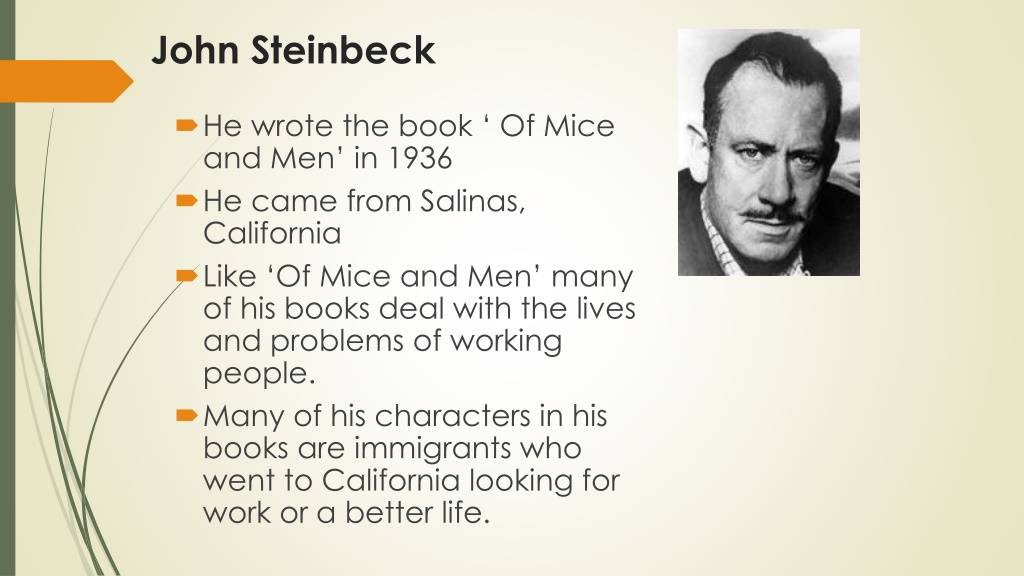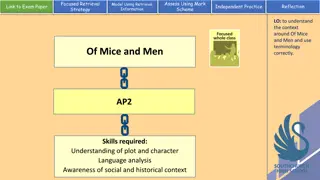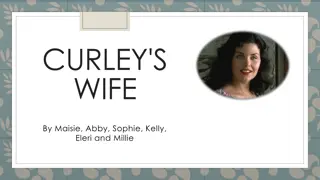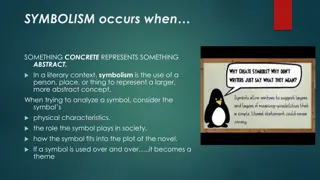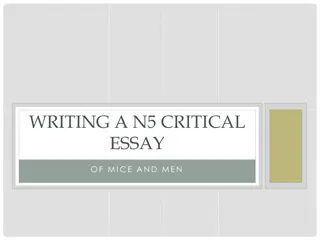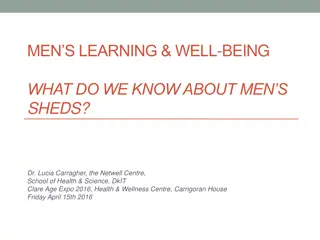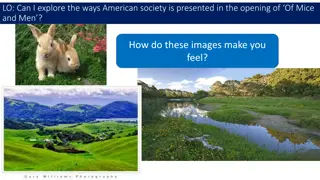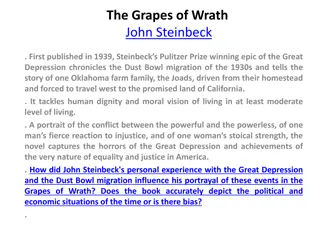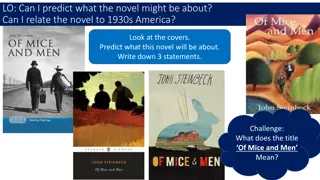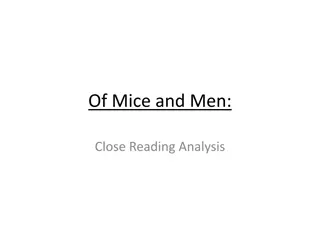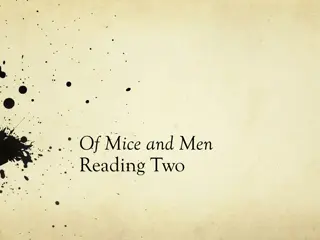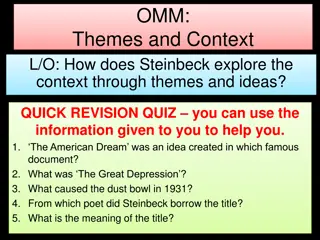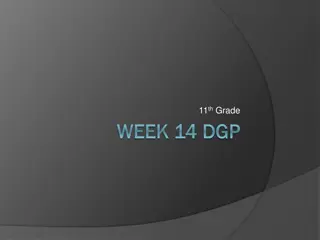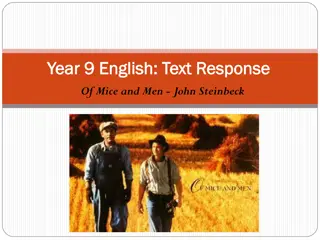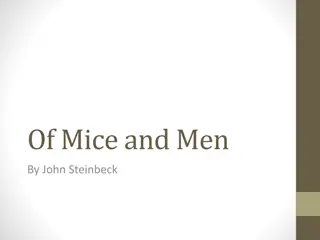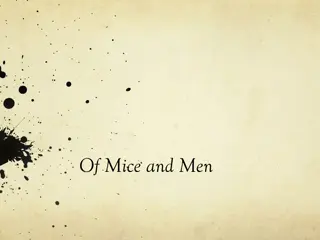Exploring John Steinbeck's Themes in "Of Mice and Men
John Steinbeck, a renowned author from Salinas, California, delves into the lives of working people and immigrants in his works. "Of Mice and Men" portrays the complex relationship between George and Lennie, exploring themes of companionship, dreams, and the harsh reality of the American Dream. Through symbolism and character dynamics, Steinbeck weaves a poignant story that resonates with readers even today.
Download Presentation

Please find below an Image/Link to download the presentation.
The content on the website is provided AS IS for your information and personal use only. It may not be sold, licensed, or shared on other websites without obtaining consent from the author. Download presentation by click this link. If you encounter any issues during the download, it is possible that the publisher has removed the file from their server.
E N D
Presentation Transcript
John Steinbeck He wrote the book Of Mice and Men in 1936 He came from Salinas, California Like Of Mice and Men many of his books deal with the lives and problems of working people. Many of his characters in his books are immigrants who went to California looking for work or a better life.
Steinbeck also uses symbolism in title to clarify the central concern (key message) of the novel. The novel takes its name from Robert Burns poem, To A Mouse , in which the speaker accidentally destroys a mouse s nest. The speaker states that the best laid plans of mice and men gang aft agley , and questions who is better off - the mouse (who lives solely in the moment) or the man (who must suffer the human anxieties of foresight and regret). It seems in this story that, although Lennie suffers seemingly the most tragic fate, in a way, George is the one who suffers most, through the agony of guilt he will feel over Lennie s death.
- Context + Quotation = EVIDENCE + ANALYSIS Lennie is physically intimidating, but his body language hints at his learning difficulties:"...and he walked heavily, dragging his feet a little, the way a bear drags his paws." At this point, part of what makes Lennie so fascinating is his touching relationship with George: "An' why? Because...because I got you to look after me, and you got me to look after you, and that's why." Lennie and George travel together, and dream of owning their own ranch, where Lennie can tend the rabbits. However, George is easily frustrated by Lennie who drinks out of a stagnant brook, and has no common sense: "You'd drink out of a gutter if you was thirsty.
PEAR paragraphs for critical essays Point and Response should link to the task very clearly so it is hard to pre-write these. Evidence and analysis however we can pre- write and learn. Evidence, as has been demonstrated, read s better and shows greater understanding of the text, if each quotation is embedded in context.
- Context + Quotation = EVIDENCE + ANALYSIS Lennie is physically intimidating, but his body language hints at his learning difficulties:"...and he walked heavily, dragging his feet a little, the way a bear drags his paws." At this point, part of what makes Lennie so fascinating is his touching relationship with George: "An' why? Because...because I got you to look after me, and you got me to look after you, and that's why." Lennie and George travel together, and dream of owning their own ranch, where Lennie can tend the rabbits. However, George is easily frustrated by Lennie who drinks out of a stagnant brook, and has no common sense: "You'd drink out of a gutter if you was thirsty. Immediately the reader begins to understand that Lennie must rely heavily on George. This reliance is also conveyed when George confiscates a dead mouse which Lennie has been hiding in his pocket. Lennie loves petting animals because of their soft fur, but the mouse s death foreshadows what is to come introducing the idea that Lennie will not be able to control his strength and could hurt someone. The manner in which George chastises Lennie only highlights his childish nature and naivety. These personality traits, coupled with his physical characteristics, are part of what makes Lennie an interesting character for whom the reader has sympathy.
Thematic Central Concern (learn up!) The Importance of Dreams and Companionship Through the tale of George and Lennie Steinbeck illustrates the importance of dreams: what the rabbit farm means to George and Lennie; how it helps them; how others Candy and Crooks react to it; how fragile the dream is. Steinbeck also shows us the importance of companionship: how Lennie needs George; how George cares for Lennie; how George resents Lennie; how Crooks has become bitter with loneliness; Candy s dog; Lennie s death at George s hands. Without dreams and friends the harshness of life in that time and place can be overwhelming for the characters. We see this demonstrated through the problems Lennie faces due to disability; George s burden of care; Candy s age and his dog; Crooks s race and finally Lennie s death at George s hands his final act of friendship to save his companion from pain and torment.
Chapter Two - George and Lennie meet some of the other ranch workers. "Curley's like a lot of little guys. He hates big guys. "'Ain't many guys travel around together,' he mused. 'I don't know why. Maybe ever'body in the whole damn world is scared of each other.' "Lennie covered his face with huge paws and bleated with terror. Blood ran down Lennie s face, one of his eyes was cut and closed I didn t wanta, Lennie cried. I didn t wanta hurt him.
Steinbeck uses dialogue with minor characters like Candy, the old swamper on the ranch, to foreshadow Lennie s conflict with Curley: "Curley's like a lot of little guys. He hates big guys. Despite this worrying statement, we can tell that Lennie appears as likeable, even vulnerable, to most people on the ranch. Slim comments later on in the novella that he can tell that Lennie ain t mean , and also says: "'Ain't many guys travel around together,' he mused. 'I don't know why. Maybe ever'body in the whole damn world is scared of each other.'
Chapter Two - George and Lennie meet some of the other ranch workers. Steinbeck uses dialogue with minor characters like Candy, the old swamper on the ranch, to foreshadow Lennie s conflict with Curley: "Curley's like a lot of little guys. He hates big guys. Despite this worrying statement, we can tell that Lennie appears as likeable to most people on the ranch. Slim comments later on in the novella that he can tell that Lennie ain t mean , and also says: "'Ain't many guys travel around together,' he mused. 'I don't know why. Maybe ever'body in the whole damn world is scared of each other.' Candy s comments suggest to the reader that Curley will take a dislike to Lennie, and this arouses our sympathy, as we already realise that Lennie is quite helpless. Slim s words suggests that it is very unusual for men to travel around from workplace to workplace: ranch life is lonely, and many of the ranch workers themselves crave company and friendship. Their travelling arrangement further emphasises the special bond that Lennie and George share. Lennie even mimics George s movements and mannerisms and, although this is perhaps subconscious, this conveys Lennie s admiration of George.
After walking into the bunkhouse, just as Lennie is laughing at a joke George has made, Curley believes that Lennie is mocking him and picks a fight. Despite his huge size, Lennie freezes as Curley hits out at him:"Lennie covered his face with huge paws and bleated with terror." In fact, it is only when George commands Lennie to fight back that he actually begins to defend himself; he grabs Curley s fist and crushes it in his own, seriously injuring him: Blood ran down Lennie s face, one of his eyes was cut and closed I didn t wanta, Lennie cried. I didn t wanta hurt him.
After walking into the bunkhouse just as Lennie is laughing at a joke he has made, Curley believes that Lennie is mocking him and picks a fight. Despite his huge size, Lennie freezes as Curley hits out at him: "Lennie covered his face with huge paws and bleated with terror." In fact, it is only when George commands Lennie to fight back that he actually begins to defend himself; he grabs Curley s fist and crushes it in his own, seriously injuring him: Blood ran down Lennie s face, one of his eyes was cut and closed I didn t wanta, Lennie cried. I didn t wanta hurt him. Steinbeck uses this key scene to highlight an important element of Lennie s characterisation: the contrast between his physical prowess and his limited intellect. The other men are shocked by Lennie s brute strength, and Curley s hand is mangled. However, this key scene makes it clear that, without George there to instruct him, Lennie would have remained paralysed with fear, and unable to defend himself. At this point, we can clearly see that Lennie is not in control of his great strength, and this makes him a danger to others (and himself).
Setting in time and place Great Depression-era America
1930s USA Mass unemployment and poverty because of the collapse of the New York Wall Street stock market.
The Depression It was worst for the farmers in the country. On top of the economic crisis, a series of droughts had ruined the crops and dried up the soil so the farmers were driven off their farms because of lack of money. These droughts mainly affected the mid-West Oklahoma and Arkansas also known as the Dust Bowl The Great Dust Storm
Where did they go? They headed west to California where the soil was good and there was supposed to be plenty of room.
The American Dream The American Dream has been a concept since the 17th century. Immigrants dreamed of a better life in America. They dreamed of making their fortunes in the goldfields. For many the dream became a nightmare. The Wall Street Crash was the start of the Great Depression.
Migration Workers Agencies Agencies were set up to direct farm workers to farms and ranches where work existed. Murray and Ready s was one of these agencies.
The Life of a Migrant Worker Steinbeck worked on a ranch when he was 19, and used his experiences there to write Of Mice and Men . The living conditions for the farm workers were very poor. Often men travelled alone but sometimes whole families had to move and all live in their car.
Setting in time and place 1930s USA (THE GREAT DEPRESSION) Mass unemployment and poverty because of the collapse of the New York Wall Street stock market. A series of droughts (affected the mid-West Oklahoma and Arkansas also known as the Dust Bowl ) ruined the crops and dried up the soil so many farmers were driven off their farms because of lack of money. The headed West in huge numbers. The living conditions for the migrant (itinerant) farm workers were very poor. California - a few miles east of Soledad . It is important to note that Soledad translates means lonely. Steinbeck gives so many of the characters obvious handicaps shows that he is trying to emphasise the power struggle which these people go through. Their differences make them vulnerable in time such as the Great Depression, where many were incredibly poor and unable to find employment. The harsh reality of a time like this meant that society in general was less tolerant of others and more selfish.
Setting and the use of a cyclical structure. The novel begins and ends in the same setting, at the river near the ranch house a few miles south of Soledad . This cyclical structure helps Steinbeck make an important point about the lives of his characters in this setting by reminding us that these characters are powerless to escape their fate in a cruel world.
Opening scene Characterisation of Lennie "...and he walked heavily, dragging his feet a little, the way a bear drags his paws. "An' why? Because...because I got you to look after me, and you got me to look after you, and that's why. "You'd drink out of a gutter if you was thirsty.
Foreshadowing Jus wanted to feel that girl s dress jus wanted to pet it like it was a mouse Well, how the hell did she know you just wanted to feel her dress?
After establishing that Lennie is strong but lacks intelligence Steinbeck reveals through George s frustrated dialogue the reason that they had to leave their last place of work: Jus wanted to feel that girl s dress jus wanted to pet it like it was a mouse Well, how the hell did she know you just wanted to feel her dress?
After establishing that Lennie is strong but lacks intelligence Steinbeck reveals through George s frustrated dialogue the reason that they had to leave their last place of work: Jus wanted to feel that girl s dress jus wanted to pet it like it was a mouse Well, how the hell did she know you just wanted to feel her dress? Although he didn t mean her any harm, Lennie has obviously been seen to attack a girl at their last workplace in Weed. This resulted in the two men being chased out of Weed by a group of men who intended to lynch them. Immediately, Steinbeck conveys the danger that could easily befall a vulnerable character like Lennie at this time. We realise that Great Depression-era America was a very harsh and unforgiving place for someone vulnerable like Lennie to live. Steinbeck uses this tale to foreshadow later events, such as the death of Curley s Wife, making the reader feel nervous. `
Foreshadowing 2 Candy and his Dog had him since was a pup. No, I couldn t do that. I had im too long, I m so used to him he was the best damn sheepdog I ever seen.
Foreshadowing 2 Candy and his Dog George and Lennie are one pair through which Steinbeck explores the importance of companionship and dreams. The second pair is an old man called Candy, whose only real friend is an old dog: had him since he was a pup. The other men in the bunkhouse complain about how badly the dog smells and suggest that Candy puts him down. Candy says: No, I couldn t do that. I had im too long, . He pleads with them to let the subject drop, I m so used to him and he was the best damn sheepdog I ever seen.
Foreshadowing 2 George and Lennie are one pair through which Steinbeck explores the importance of companionship and the rejuvenating effect of dreams. The second pair is an old man called Candy, whose only real friend is an old dog: had him since was a pup. The other men in the bunkhouse complain about how badly the dog smells and suggest that Candy puts him down. Candy says: No, I couldn t do that. I had im too long, . He pleads with them to let the subject drop, I m so used to him and he was the best damn sheepdog I ever seen. The other men, all loners and migrant workers, cannot understand the idea of friendship and simply want the dog shot because it is no longer useful and is a nuisance in the bunkhouse. They do not recognise, nor sympathise with, Candy s affection for the dog and tragically one of them takes the old dog outside and puts it down with a pistol. This event foreshadows the end of the story when George will also have to kill his best friend, Lennie with the same pistol, the difference is that George does it himself, rather than have someone else do it for him.
Candy and the Dream When his dog is symbolically killed Candy sinks into despair. But, when he overhears George and Lennie talking about the rabbit farm, he begins to speak excitedly and eagerly . He offers his money to George and Lennie to help buy the property saying I ain t got no relatives nor nothing.
Candy and the Dream When his dog is symbolically killed Candy sinks into despair. But, when he overhears George and Lennie talking about the rabbit farm, he begins to speak excitedly and eagerly . He offers his money to George and Lennie to buy the property because I ain t got no relatives nor nothing. Like Candy, his dog was old, crippled, and struggled to work. He knows that he will not be able to stay on at the ranch when he becomes too old to be of use and that he will be fired. His future only holds more loneliness and then death. Steinbeck implies that through exposure to the Dream , some of the damage that the setting has done to Candy is healed by the idea of something better than the grim future he sees before him. The dream rejuvenates him.
The Dream in more detail George and Lennie have a dream that one day they will own their own place and live off the fatta the land. Steinbeck introduces a myriad of thematic concerns in Chapter one when Lennie entreats George to tell him about the rabbit farm even though Lennie knows it off by heart. George speaks the words, rhythmically as though he had said them many times before .; Guys like us, that work on ranches, are the loneliest guys in the world. They got no family. They don t belong no place. They come to ranch an work up a stake and then they go inta town and blow their stake, and the first thing you know they're poundin their tail on some other ranch. They aint got nothing to look ahead to
The Title The title comes from a poem by a Scottish poet Robert Burns. "To a Mouse, On Turning Her Up in Her Nest with a Plow," The best laid schemes o mice and men Gang aft agley (often go wrong) And leave us nought but grief and pain For promised joy!
Setting and Theme of Dreams George and Lennie have a dream that one day they will own their own place and live off the fatta the land. Steinbeck introduces a myriad of thematic concerns in Chapter one when Lennie entreats George to tell him about the rabbit farm even though Lennie knows it off by heart. George speaks the words, rhythmically as though he had said them many times before .; Guys like us, that work on ranches, are the loneliest guys in the world. They got no family. They don t belong no place. They come to ranch an work up a stake and then they go inta town and blow their stake, and the first thing you know they're poundin their tail on some other ranch. They aint got nothing to look ahead to Here, in the precursor to George s The Dream speech we learn that the shared dream is what unites the men and motivates them to continue though they have few pleasures in their life. This shows that, even though Lennie is characterised as childlike and George as cynical and world weary, both men are equally invested in this goal, and both need it to help them get through their horrible circumstances caused by their setting in time. Through the dream of the rabbit farm, Steinbeck shows that dreams help people to survive, no matter how difficult achieving them seems. Through George and Lennie s dream Steinbeck alludes symbolically to the American Dream the idea that every man can be successful. However, as the novel s title (taken from Robert Burn s To A Mouse ) implies, no matter how hard we try to plan our future, things often go wrong.
Curleys Wife Steinbeck uses other minor characters to highlight the unpleasant side of life at the ranch. In Chapter Two, Steinbeck uses dialogue to reveal the predatory nature of people in this setting. Candy, the old swamper, introduces us to the character of Curley s wife: Know what I think? George did not answer. Well I think Curley s married a tart.
Curleys Wife In Chapter Two, Steinbeck uses dialogue to reveal the predatory nature of people in this setting. Candy, the old swamper, introduces us to the character of Curley s wife: Know what I think? George did not answer. Well I think Curley s married a tart. Curley s wife is the only woman living on the ranch. She acts in a provocative manner and is said by Candy to be giving the other men the eye . Steinbeck portrays Curley s wife very negatively: she is seen as a rat-trap who lures the other men into trouble. However, we are also encouraged to feel sorry for her we do not find out her name, and she is dismissively called Curley s wife by the men whether out of fear (of Curley) or disinterest, we do not know. These features of characterisation highlight to the reader that America was a very sexist place at this time. Women were not seen as equal to men. Curley s wife s mistreatment and resulting misery through the novel emphasises the idea that life without something to look forward or friends is unbearable.
Crooks 1 Steinbeck explores the transforming impact dreams can have on people through the character of Crooks who is psychologically restored when he becomes involved in George and Lennie s dream. Crooks is a particular victim of the novel s setting: black, he has suffered a lifetime of racism. When Crooks is introduced, Steinbeck characterises him as a bitter and cruel character who torments Lennie by pointing out risks and problems in George and Lennie s plan: Nobody ever gets to heaven, and nobody gets no land .
Crooks Steinbeck explores the transforming impact dreams can have on people through the character of Crooks who is psychologically restored when he becomes involved in George and Lennie s dream. Crooks is a particular victim of the novel s setting: black, he has suffered a lifetime of racism. When Crooks is introduced, Steinbeck characterises him as a bitter and cruel character who torments Lennie by pointing out risks and problems in George and Lennie s plan: Nobody ever gets to heaven, and nobody gets no land . Crooks is nihilistic after a lifetime of isolation and disappointment. Like Candy, a physical disability sets him apart from the other workers and makes him worry that he will soon wear out his usefulness on the ranch. Crooks' isolation is made worse by the fact that, as a black man, he is relegated to sleep in a room in the stables; he is not allowed in the white ranch-hands quarters and not invited to play cards or visit brothels with them. With Crooks, the same unjust, predatory rules hold true for people based on the colour of their skin. This makes him bitter since he is clearly an intelligent man and so he is aware of the injustice wrought upon him. The reader has already witnessed how the world conspires to crush men who are debilitated by physical or mental infirmities - with Crooks, the same unjust, predatory rules hold true for people based on the colour of their skin and so we can understand why Crooks is wary of the white men and bitter towards them.
Crooks 2 Through this interaction Steinbeck alludes to the theme of the Predatory Nature of Men. Crooks delights in teasing Lennie about George not returning because he has been made bitter through loneliness and isolation as Lennie said, the ranch is a mean place. It is a setting where kindness and empathy are rarely shown and where cruelty and bitterness thrive. However, when Candy mentions that he s putting in money, Crooks has reason to believe the dream might be possible and he quickly asks if he can join them, his previous bitterness disappearing. Steinbeck shows that faith in a dream can draw someone back from bitter hopelessness.
Crooks 2 Crooks begins to open up to Lennie eventually, but this advancement is short lived. Soon after Curley s wife appears, and tells Crooks: Well, you keep your place then, Nigger. I could get you strung up on a tree so easy it ain t even funny. From this scene, we can see that Crooks yearns for companionship and acceptance like many of the other characters. But when Curley s wife acts cruelly towards him, it strips away the trust he was beginning to feel towards the other men. Likewise we know that, however despicable her comment might be, we know also that Curley s wife is mistreated and lonely herself and through this scene, Steinbeck reminds us of the nature of discrimination and intolerance those who are treated cruelly often become cruel themselves as a defence mechanism. - hatred only breeds more hatred.
Turning Point Death of Curleys wife However they impact people, Steinbeck ultimately uses the plot of Of Mice and Men to explore the fragility of dreams. Steinbeck carefully foreshadows Lennie s killing of Curley s wife throughout the novel, so that when it happens the reader is not surprised. When they discover her lifeless body Candy is still keen to pursue the dream of the little farm with George, but for George this is the end: I think I knowed. I think I knowed from the very first we d never do her. He usta like to hear about it so much I got to thinking maybe we would.
Turning Point Death of Curleys wife However they impact people, Steinbeck ultimately uses the plot of Of Mice and Men to explore the fragility of dreams. Steinbeck carefully foreshadows Lennie s killing of Curley s wife throughout the novel, so that when it happens the reader is not surprised. When they discover her lifeless body Candy is still keen to pursue the dream of the little farm with George, but for George this is the end: I think I knowed. I think I knowed from the very first we d never do her. He usta like to hear about it so much I got to thinking maybe we would. We understand that George will now become like all the other guys. It is clear from the beginning of the novel that the rabbit farm will be a difficult thing to get, and it is also clear that Lennie cannot long survive the harsh setting. As George and Lennie s dream becomes more achievable, the signs that it will fall to pieces Curley s bullying of Lennie; Curley s wife s tormenting of Lennie; Lennie s accidental killing of the puppy begin to mount. Steinbeck shows that, even when our dreams seem just within reach, predictable problems can still destroy them completely.
Resolution ending when George Kills Lennie Steinbeck uses another key incident, the resolution of the novel, to show the truly special relationship that existed between George and Lennie and reveal the theme of dreams, loneliness and companionship. George realises that he has no choice but to kill Lennie. He thinks maybe they could bring Lennie in to be locked up, but Slim disagrees: Curley s gonna want to shoot him. Curley s still mad about his hand. An s posethey lock him up an strap him down and put him in a cage? That ain t no good George . When he finds Lennie George tries to make Lennie think everything is normal. He tries to give him hell , but he can t and instead he makes sure that, before he kills him, Lennie knows he is not angry with him: No Lennie, I ain t mad. I never been mad an I ain tnow. That s a thing I want you to know.
Resolution ending when George Kills Lennie Steinbeck uses another key incident, the resolution of the novel, to show the truly special relationship the existed between George and Lennie and reveal the theme of dreams, loneliness and companionship. George realises that he has no choice but to kill Lennie. He thinks maybe they could bring Lennie in to be locked up, but Slim disagrees: Curley s gonna want to shoot him. Curley s still mad about his hand. An s pose they lock him up an strap him down and put him in a cage? That ain t no good George . When he finds Lennie, George tries to make Lennie think everything is normal. He tries to give him hell , but he can t and instead he makes sure that Lennie knows he is not angry with him: No Lennie, I ain t mad. I never been mad an I ain tnow. That s a thing I want you to know. All of this shows us how much George cares for Lennie, and that he is a true friend- protecting him till the end. George will now be just like all the other men, and his dream is over. No one except Slim understands that what George did was actually a great act of kindness and no one will understand how George feels now, and what a great loss it is to him to be without Lennie.
Group Discussion Task How does John Steinbeck explores an important theme in his novel Of Mice and Men. Organise your presentation by ensuring everyone analyses a different aspect of the text (character, technique, structure, setting and plot) BUT be prepared to justify and discuss whatever ANYONE says. Short notes are encouraged but do not overly rely upon them
